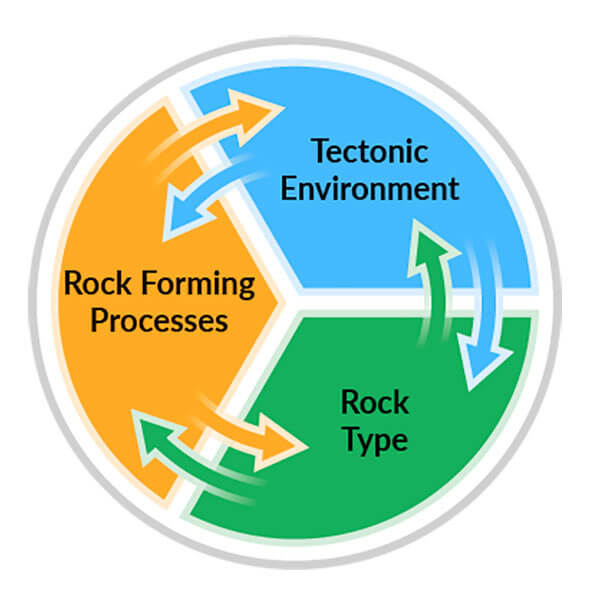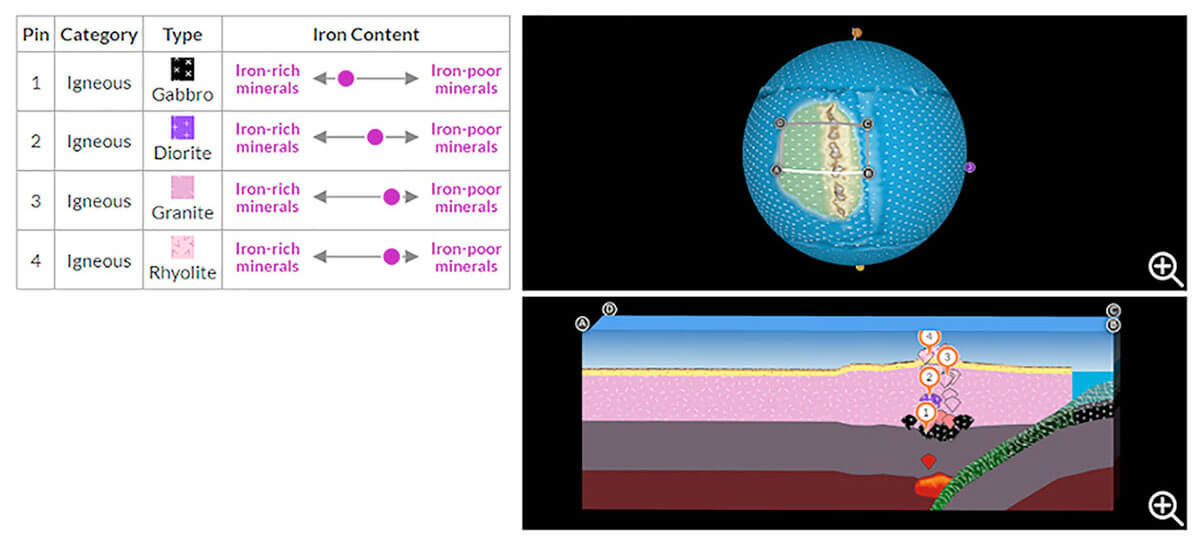Making Connections: Rocks & Tectonics
“Rocks are the records of events that took place at the time they formed. They are books. They have a different vocabulary, a different alphabet, but you learn how to read them.” – John McPhee, Annals of the Former World
Earth science teachers often have a collection of rock and mineral samples accompanied by scratch plates and vinegar droppers tucked away in their supply closets. These “rocks in a box” are pulled out for hands-on labs in which students learn to differentiate between calcite and quartz, granite and gneiss, shale and slate. However, labs about rocks and minerals miss the bigger story of their context within larger Earth systems. Funded by the National Science Foundation, the Geological Construction of Rock Arrangements from Tectonics: Systems Modeling Across Scales project, called TecRocks for short, aims to change that. Our goal is to help students develop explanations that connect rock type formation with the conditions and processes found in tectonic environments, using simulations and computer-based tools to observe the geologic processes that would otherwise be inaccessible.
Most of us have seen (or taught from) a “rock cycle” diagram (Figure 1), but if you look at it long enough, you realize it is both abstract and misleading. With arrows pointing from one rock type to another, the rock cycle implies that rocks transform from one rock type to another over and over. But rocks do not go through such continuous transformation. While rocks may transform over the course of geologic time, they typically do not go round and round the cycle. Further, the processes in the rock cycle—weathering, melting, cooling—are not linked to the tectonic processes and environments that produce the transformations. For example, igneous rocks can become metamorphic rocks through heat and pressure, but the rock cycle diagram doesn’t indicate where or why this happens.

Figure 1. A typical rock cycle with no reference to tectonic processes and environments.
TecRocks Explorer and the Rocks & Tectonics module
The NGSS standards for middle and high school Earth science emphasize teaching about the Earth through the development and use of models and, more specifically, teaching about Earth’s materials within the context of the processes that produce them. When we started planning the TecRocks curriculum module to address these standards, we asked what students should learn about the origin and formation of rocks. Should they even be identifying minerals?
To begin, we needed to show how rock-forming processes and tectonic processes are interconnected. We developed a unique online computational model and simulation for students to investigate the relationship between Earth’s tectonic system and the location of rock-forming environments. The TecRocks Explorer model offers students the opportunity to investigate rock formation within the context of a planet-wide system of plate tectonics. Students set up tectonic plate interactions on an Earth-like planet and observe and collect data focused on how and why different rocks form and are distributed on Earth.
For example, students can see magma being formed in the mantle above the subducting plate at an oceanic-continental convergent boundary (Figure 2). They can analyze the change in the rock types forming as magma rises and solidifies at different depths. They can also observe the basalt and gabbro undergoing metamorphism as the rock layers move deeper because they are experiencing temperature and pressure changes as the plate subducts.

Figure 2. A screenshot of the TecRocks Explorer model showing a cross-section of an oceanic-continental convergent boundary.
We also developed a curriculum module centered around TecRocks Explorer to help transform the traditional teaching sequence about rocks, landforms, and plate tectonics as separate entities and events to a holistic view that is driven by tectonics. The “Rocks & Tectonics” module explores real-world phenomena related to the formation and distribution of rocks on Earth and connects them to plate tectonics.
The module leads students to deeper reasoning about the connections between tectonic settings on Earth, the conditions present there, and the resulting types of rocks that form. While typical rock cycle lessons are organized by rock type and describe the characteristics of rocks primarily for the purpose of classification, our TecRocks module is organized by tectonic setting and connects those settings to the conditions present that result in rock formation.
Students explore divergent and convergent boundaries; investigate magma-forming processes that create island arcs or continental volcanic mountains; explore rock transformation processes in subduction zones and along continental collisions; and research sedimentary rock formation along passive continental margins (places away from tectonic boundaries). (See the “Rocks & Tectonics Module Overview” sidebar on page 6 for activity descriptions.)
Throughout the module, students should be able to use reasoning that reflects the integration of ideas related to the tectonic environment, rock type, and rock-forming process. Figure 3 represents a flow for how the ideas are connected.The arrows show the sensemaking necessary to build explanations that connect tectonic environments to rock-forming processes to rock types.

Figure 3. The TecRocks reasoning framework. Connecting ideas helps students reason about the interrelationships among tectonic environments, rock-forming processes, and rock types.
For example, in one activity, students are shown maps of the rock types on the ocean floors as if all the sediment were removed (Figure 4). They observe that all ocean floors are made of one rock type, basalt. To investigate this phenomenon, students use TecRocks Explorer. When they draw a cross-section across a divergent boundary between two oceanic tectonic plates, they observe where magma forms (Figure 5), the type of plate motion, and the different rock types that form as the magma cools. Stu- dents can follow the rock that forms along the mid-ocean ridge and moves away from the plate boundary and use evidence from the model to reason that oceanic crust is formed at divergent plate boundaries and that the ocean floor is made up entirely of basalt. (Try the “Monday’s Lesson” on page 7 with your students to learn more about basalt.)

Figure 4. The ocean floor covered in ocean sediment (left). When sediment is removed, the ocean floor around the world is all made of basaltic rocks (right).

Figure 5. With TecRocks Explorer set up to show a divergent boundary, students can see magma rising and cooling as it adds rocks to the plates on either side of the boundary.
In a traditional approach, students are able to identify the characteristics of basalt, describing it as an igneous rock that is black and has small, nearly invisible crystals. In the TecRocks approach, students can sample rock types and use a pressure/temperature tool to explore conditions with the goal that they are able to reason about how the formation of basalt happens where magma rises from the mantle and cools between diverging plates.
To help students determine other relationships between variables (e.g., depth and rock composition), TecRocks Explorer also has a data collection tool. Students can click anywhere in the cross-section to collect data that is then organized into a data table to help them discern patterns (Figure 6).

Figure 6. Students can click in the model to collect data, which is populated in a table. Tags in the model show where data was collected.
Curriculum pilot
During the first TecRocks pilot in November 2022, students were able to demonstrate reasoning between rock type, tectonic environment, and rock-forming process. For example, when asked to provide an explanation for the rocks that are forming on the Pacific Ocean floor, many students linked rock formation to either the divergent boundary, the magma formation, or both. One student said,“As plates move away from each other, magma is allowed to rise up to the surface at the ocean floor, where it crystallizes and spreads out to make quick-cooling basaltic rocks.” Another reasoned,“The ocean floor at the East Pacific Ridge is formed from magma because the plates at the Ridge are divergent, this means that when the plates move away from each other that lets magma from the mantle to push up and form rocks when cooled. You can see this in the [model] because there is a magma chamber in the ductile mantle that can be brought to the surface and make rocks like gabbro and basalt.”
We also heard from teachers about the pilot implementation. One teacher described how she used the module in conjunction with her previous lessons on igneous rocks, weaving various activities together. After her students finished the TecRocks module, they took the usual igneous rocks quiz, during which they moved around the room to stations with different igneous rock samples and were asked about the conditions of their formation as well as tectonic settings.The teacher compared students’ average quiz scores to those of previous years and found a significant improvement.
Conclusion
All rock types—metamorphic, igneous, and sedimentary—hold stories about the conditions and processes that existed while they were forming. They also reveal information about the location on Earth where they likely were formed. With the TecRocks Explorer students can employ authentic scientific practices such as modeling and data collection to investigate rock formation and develop sophisticated reason- ing about the interconnections between tectonic environments, rock-forming processes, and rock types. Like geoscientists, students can begin thinking about what a rock tells us about Earth in the past when it was formed. Knowing how to read the stories told by rocks is far more interesting than simply memorizing their names.
Rocks & Tectonics Module Overview
Activity 1: You rock!
Demographic and curiosity survey.
Activity 2: Earth: It’s rocky out there!
There are different types of rocks and there are patterns to their distribution. What could cause this?
Activity 3: Eruptions everywhere
Magma formation and volcanoes on Earth are associated with certain types of tectonic settings. Magma cools to form igneous rocks that can create new land or new ocean crust.
Activity 4: Recipes for rock
Converging plates can cause one to subduct, which results in deep magma formation. The way magma cools as it rises slowly through overlying crust results in the formation of increasingly iron-poor igneous rocks.
Activity 5: Rock transformation
Along convergent boundaries, the changes in pressure and heat that rocks experience when they are subducted or compressed result in the formation of metamorphic rocks.
Activity 6: From sediment to rock
Active plate boundaries aren’t the only places that rocks can form. Sediments that are transported by wind and water and settle in a location far from active plate boundaries form sedimentary rock layers.
Stephanie Seevers (spseevers@gmail.com) is a teacher at Evergreen High School, CO, and a consultant for the Concord Consortium.
Amy Pallant (apallant@concord.org) is a senior scientist.
This material is based upon work supported by the National Science Foundation under grant DRL-2006144. Any opinions, findings, and conclusions or recommendations expressed in this material are those of the author(s) and do not necessarily reflect the views of the National Science Foundation.

